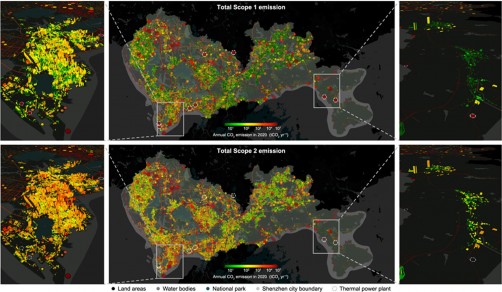Top Stories
Megacities Shift Focus on Carbon Emissions from Producers to Consumers

Urban areas now house over half of the global population, contributing more than 70% of fossil-fuel-derived carbon dioxide (CO2) emissions. In particular, megacities like Shenzhen, China, are under increasing pressure to reconcile rapid urban development with climate action goals. Traditional emissions tracking methods, which often provide only coarse annual totals, fail to capture the nuanced spatial and sectoral diversity of emissions, hampering effective policymaking.
Researchers from the Tsinghua Shenzhen International Graduate School have addressed these challenges in a study published on July 12, 2025, in the journal Environmental Science and Ecotechnology. The study introduces a novel carbon accounting model that assesses both Scope 1 and Scope 2 emissions in fine detail, revealing how responsibility for emissions often shifts from producers to consumers.
By employing a combination of building simulations, traffic data, industrial statistics, and land use maps, the researchers focused on emissions down to individual structures. The data uncovered a significant portion of Shenzhen’s emissions comes from indirect sources, with in-depth analysis revealing that in 2020, the city’s total CO2 emissions reached 52.0 Tg, comprised of 44.8 Tg (approximately 86.3% ) from Scope 1 emissions and 7.2 Tg (around 13.7% ) from Scope 2 sources.
New Insights into Emissions Responsibility
While power plants and road traffic were identified as the primary contributors to direct emissions, the study indicated that over 60% of total Scope 2 emissions stemmed from electricity consumption in residential, commercial, and industrial buildings. More strikingly, when emissions were reallocated to consumption points, the identified emission hotspots expanded significantly, from 0.7% to 12.7% of the city area. This shift highlights a broader responsibility for emissions that extends beyond traditional industrial centers.
The findings emphasize that 84.8% of Shenzhen’s districts are consumption-led, underscoring the urgent need for initiatives focused on energy efficiency and the promotion of green buildings. By detailing emissions disparities across various districts and population densities, the research provides actionable insights that can guide targeted reductions in the most impactful areas.
Prof. Bo Zheng, a co-author of the study, stated, “Our research demonstrates that cities must move beyond total emissions and consider where, how, and by whom emissions are generated and used.” He further noted that the new landscape-level framework reveals hidden carbon flows linked to electricity consumption, particularly in densely populated areas. This empowers urban planners and policymakers to design interventions that are both effective and equitable.
Implications for Urban Climate Strategies
The study presents a scalable framework that can inform targeted climate policies, such as the installation of solar panels on high-consuming buildings, promoting energy-efficient designs, and transitioning to cleaner energy sources in production-led zones. By clarifying who holds carbon responsibility within complex urban ecosystems, this approach supports climate justice initiatives.
As cities increasingly adopt similar frameworks, they can take coordinated, data-informed actions to achieve emission reduction goals. This innovative model not only transforms how urban carbon is measured but also how cities can effectively act on their findings. The research sets a foundation for smarter carbon tracking in megacities globally, paving the way for a more sustainable urban future.
This study was supported by the Shenzhen Science, Technology, and Innovation Commission under Grant No. WDZC20220810110301001, marking a significant step towards understanding urban carbon flows and enhancing climate action strategies worldwide.
-

 Lifestyle3 months ago
Lifestyle3 months agoLibraries Challenge Rising E-Book Costs Amid Growing Demand
-

 Sports3 months ago
Sports3 months agoTyreek Hill Responds to Tua Tagovailoa’s Comments on Team Dynamics
-

 Sports3 months ago
Sports3 months agoLiverpool Secures Agreement to Sign Young Striker Will Wright
-

 Lifestyle3 months ago
Lifestyle3 months agoSave Your Split Tomatoes: Expert Tips for Gardeners
-

 Lifestyle3 months ago
Lifestyle3 months agoPrincess Beatrice’s Daughter Athena Joins Siblings at London Parade
-

 World3 months ago
World3 months agoWinter Storms Lash New South Wales with Snow, Flood Risks
-

 Science3 months ago
Science3 months agoTrump Administration Moves to Repeal Key Climate Regulation
-

 Science2 months ago
Science2 months agoSan Francisco Hosts Unique Contest to Identify “Performative Males”
-

 Business3 months ago
Business3 months agoSoFi Technologies Shares Slip 2% Following Insider Stock Sale
-

 Science3 months ago
Science3 months agoNew Tool Reveals Link Between Horse Coat Condition and Parasites
-

 Sports3 months ago
Sports3 months agoElon Musk Sculpture Travels From Utah to Yosemite National Park
-

 Science3 months ago
Science3 months agoNew Study Confirms Humans Transported Stonehenge Bluestones









